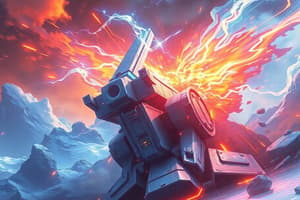Podcast
Questions and Answers
What is work done defined as?
What is work done defined as?
The product of the force and distance in the direction of the force.
What formula represents work done?
What formula represents work done?
- W.D = F + d
- W.D = F - d
- W.D = F x d (correct)
- W.D = F / d
What is the SI unit of energy?
What is the SI unit of energy?
Joules, J
No work is done if the object moves.
No work is done if the object moves.
What is the equation for kinetic energy?
What is the equation for kinetic energy?
What does the law of conservation of energy state?
What does the law of conservation of energy state?
Work done against friction is equal to __________.
Work done against friction is equal to __________.
Which of the following is NOT a method of energy transfer?
Which of the following is NOT a method of energy transfer?
What is power defined as?
What is power defined as?
Pressure is defined as force acting perpendicularly per unit area.
Pressure is defined as force acting perpendicularly per unit area.
What is the formula for pressure due to a liquid column?
What is the formula for pressure due to a liquid column?
Which situation describes a hydraulic system?
Which situation describes a hydraulic system?
What is conduction?
What is conduction?
What are the three processes of energy transmission?
What are the three processes of energy transmission?
Radiation requires a medium to transfer energy.
Radiation requires a medium to transfer energy.
What affects the rate of heat radiation?
What affects the rate of heat radiation?
Flashcards are hidden until you start studying
Study Notes
Work Done
- Work done is the product of force and distance in the direction of the force, resulting in energy transfer between systems.
- Formula: Work Done (W.D) = Force (F) x Distance (dist) measured in Joules (J).
- Example: For a 10 N force moving 5 m, W.D = 50 J; Against gravity, a 50 N force over 3 m results in W.D = 150 J.
- If no movement occurs or the force is perpendicular to the direction of travel, no work is done.
Work Done Against Friction
- Work done against friction leads to energy loss; calculated by: Frictional Force x Distance moved.
Energy Transfer
- Energy is seen as a non-physical entity transferable between stores while total energy remains constant.
- Four pathways for energy transfer:
- Mechanically (force over distance)
- Heating (temperature difference)
- Waves (electromagnetic or mechanical)
- Electrically (charges moving across potential difference).
Energy Types
- Kinetic Energy (K.E) calculated as K.E = ½ mv².
- Gravitational Potential Energy (G.P.E) given by G.P.E = mgh, where h indicates change in vertical height.
Law of Conservation of Energy
- Energy cannot be created or destroyed; it can only change forms or transfer between stores.
- For isolated systems, total energy remains constant: (P.E)A + (K.E)A = (P.E)B + (K.E)B, assuming no energy losses.
Power
- Power is defined as the rate at which work is done or energy is transferred.
Energy Dissipation
- Energy dissipation occurs when energy is lost to non-useful stores due to factors like friction and air resistance; for example, heated electrical wires.
Efficiency
- Efficiency (η) is the ratio of useful energy or power output to energy or power input.
Pressure
- Pressure is defined as force per unit area, measured in Pascals (Pa = N/m²).
- Inverse relationship exists between contact area and pressure: greater area reduces pressure, and smaller area increases pressure.
Liquid Pressure
- Formula for pressure due to a liquid column: P = hρg, where h is height, ρ is density, and g is gravitational field strength.
- Liquid pressure is independent of the cross-sectional area.
Manometer and Barometer
- Manometers measure gas pressure; pressure difference calculated by height difference in liquid.
- Barometers measure atmospheric pressure; normal atmospheric pressure corresponds to approximately 760 mm Hg.
Hydraulic Systems
- Hydraulic systems utilize incompressible liquids under pressure; Pascal's law applies (pressure exerted equally in all directions).
Thermal Processes
- Energy transfer requires a temperature difference; occurs from high to low temperature until thermal equilibrium is reached.
- Conduction involves molecular vibration transfer, more effective in solids.
- Convection transfers energy through fluid movement based on density changes.
- Radiation involves energy transfer via electromagnetic waves, does not require a medium.
Applications
- Thermal flasks minimize energy loss by preventing convection and conduction with vacuum spaces and reflective surfaces.
- Double-layered windows/trapped air reduce conduction due to air being a poor thermal conductor.
Key Concepts in Thermal Processes
- Energy transfer mechanisms: conduction (molecular vibration), convection (density differences in fluids), radiation (electromagnetic waves).
- Factors affecting radiation include surface color, temperature, and area. Dull, dark surfaces are better emitters/absorbers compared to shiny, reflective surfaces.
Studying That Suits You
Use AI to generate personalized quizzes and flashcards to suit your learning preferences.




